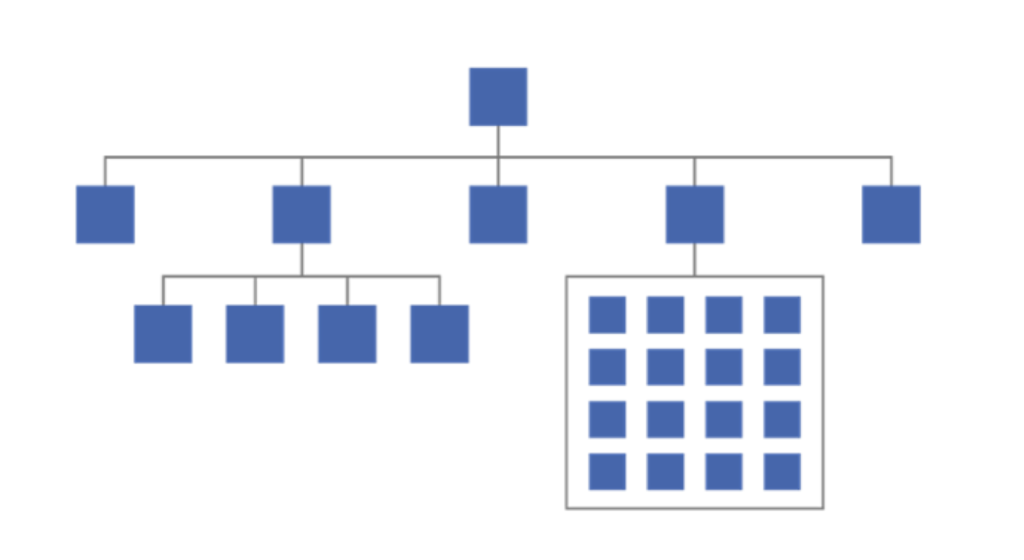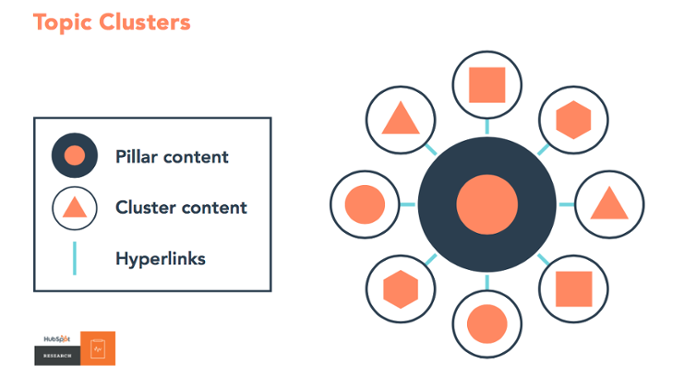SEO Topic Cluster Model
With every breakthrough in the world of technology, culture and human behavior undergo tectonic shifts. In today’s world, content production has been disrupted not only because search engines are getting smarter but also because users are scavenging the content like never before. This has made the ever so abundantly used long-tail keyword content production a thing of SEO stone age. Now SEO demands the content strategy to focus on brand visibility across several recognisable core topics that directly relate to your user personas using a SEO topic cluster model. The best way to do this is by restructuring your site’s architecture to save your content from cluttering and eventually becoming a graveyard of information that will eventually be lost to potential readers through Google’s algorithmic filter.
Typically, most of the content on the site is organised using a hierarchical model. As per the mode, homepage sits on the top, which is followed by several content layers, each layer digging into the distinct topic into the structure.
What a typical hierarchy based site looks like
And although there is nothing inherently wrong with this structure, it misses out on one important factor – collecting related content together. For example, your blog posts might reside at the same level but never be interlinked together. And that’s in spite of them covering the same topic.
Topic clusters change that approach and technology has changed the culture of SEO from keyword to topic cluster.
From the SEO perspective, the topic cluster contains a “pillar page”, that acts as the main hub of content for an overarching topic. The pillar page is hyperlinked to ‘cluster-subtopic content’ pages that are related to the core topic. And, to create further bond of togetherness amongst the pages, there are internal links between the sub-topics. This extensive linking action sets the cluster in motion, and companies are able to see the SEO lead generation to take effect immediately.
“The topic cluster model, at its very essence, is a way of organising a site’s content pages using a cleaner and more deliberate site architecture.”
Create a Topic Cluster plan
At the heart of a topic cluster plan, sits your content strategy. To understand this better, we will look at the conversation between the CEO and marketing manager of the startup, specializing in providing jobs to fitness instructors around in Australia. In order to develop content for the website, the CEO and the manager determine the key topic and related topics pertaining to the fitness industry. In response, they decided to create a cluster by developing an original article about the fitness jobs and the subtopic content giving answers to other questions and quick and easy route to find those answers without having to go back to Google search results.
That’s exactly what topic clusters do.
What an extensive topic cluster model looks like according to Hubspot Research
Let’s go step by step to see how the blog posts were organised by identifying content gaps.
Step one: Organise the content
When the marketing team decided to get started restructuring the blog page on the website, they found that all the informative blogs are out there under separate categories but they are not connected. So the team decided to connect more than 1500 blogs posts across several topics related to the fitness industry. The first step of this process was to organise by exploring different topic areas blog posts and putting them into topics that were broad enough to write about in 20-30 different blog posts, but not so broad that a pillar page couldn’t dive into the topic in any sort of depth. The team identified the myriad and created a cluster for different topics, related to training opportunities, jobs, and events. So, as you can imagine, this process took a little while: as they had to audit all of the content and separate it into groups of blog posts. Then, they had to identify pillar pages and content gaps.
Step two: Identify the pillar page, content gaps, and content duplicates
The most appealing thing about a beauty culture is that it compels the team to evaluate the database of content and make sure that all the relevant content is shared about a particular topic to the reader. Therefore, it is imperative for the team to conduct a thorough keyword research about the key topic, once the topic has been identified.
Your quick guide to keyword strategy for SEO
The key things you need to identify during this content audit are:
- What is your pillar page?
- Where are there content gaps?
- Where are content duplicates?
Pillar Page
Pillar page is like the content home page, the one-stop. A pillar page covers the topic thoroughly and broadly, so a visitor could answer any basic questions about the topic. It shouldn’t hunt intrinsically into answering specific questions, that’s what blog posts are for, the subtopic content pages.
Content Gaps
Once the team has conducted the keyword research, they have to search and choose the keywords related to your topic that have the highest search volume. Then, determine if they have already written a blog post about that keyword. If the blog post is already written on the topic, it gets easier, because the next step is to link the pages. If not, then the marketing team of the company will have to write content for all the keywords to ensure integration and comprehensiveness of the website content. Moreover, it is important for the team to remember that they might already have content that addresses the keyword, but they might need to use on-page SEO strategies to target a blog post for that keyword.
Content Duplicates
Considering that the site had several blog posts covering numerous related topic, the ranking of the keywords was overlapping and competing against each other. By understanding duplicate keywords and their effect on SEO, the team combined the information in these posts on the highest-ranking URL, and redirect the other blog posts towards it.
Duplicate Keywords on Webpages and their effect on SEO
Step Three: De-Linking and Re-Linking
The least glamorous part of the process is de-linking because it comprises of manual labor in terms of reviewing and removal of all the internal hyperlinks to ensure that the new linkage system is all comprehensive. So, to improve domain authority of every blog post and webpage in the cluster, the team internally linked every topic within the cluster to the pillar page.
What the Fitness Job Board start-up company’s topic cluster looked like
So how did it go?
Once the cluster was set and running, the results spoke for itself- it was slow, steady, and positive growth. The company started to see improvement in search rankings, the keywords were reflecting on the top searches, and backlinks were strengthened. In the most recent analysis, they experienced a positive month-over-month growth in the number of keywords we have ranking on the first page of Google SERPs. Moreover, there were considerably more keywords closing in on the second and third pages, with strong future growth projection.
So SEO Sydney can see that the beauty of this model is that you can spend a lot more time optimizing your pillar content for conversions and your cluster content for traffic. This saves a lot of time compared to the traditional model of optimizing each individual post. It also makes it easier for the company to give a better user experience while sending a positive signal to the search engines with the new site architecture. This pillar content brings in a substantial amount of new leads every month and gets a considerable amount of traffic. Tools work particularly well for pillar content because they are often made of lasting and relatable content, which gets shared a lot.
The basic premise behind building a topic cluster content program is to enable a deeper coverage across a range of core topic areas, while creating an efficient information architecture in the process.
Do you need help developing a content strategy that delivers results? Check out SEO Sydney – the experts in all things SEO today!





